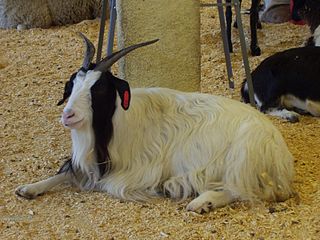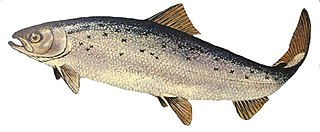
Aquaculture, also known as aquafarming, is the controlled cultivation ("farming") of aquatic organisms such as fish, crustaceans, mollusks, algae and other organisms of value such as aquatic plants. Aquaculture involves cultivating freshwater, brackish water and saltwater populations under controlled or semi-natural conditions, and can be contrasted with commercial fishing, which is the harvesting of wild fish. Aquaculture is also a practice used for restoring and rehabilitating marine and freshwater ecosystems. Mariculture, commonly known as marine farming, is aquaculture in seawater habitats and lagoons, as opposed to freshwater aquaculture. Pisciculture is a type of aquaculture that consists of fish farming to obtain fish products as food.

A genetically modified organism (GMO) is any organism whose genetic material has been altered using genetic engineering techniques. The exact definition of a genetically modified organism and what constitutes genetic engineering varies, with the most common being an organism altered in a way that "does not occur naturally by mating and/or natural recombination". A wide variety of organisms have been genetically modified (GM), including animals, plants, and microorganisms.

Fish farming or pisciculture involves commercial breeding of fish, most often for food, in fish tanks or artificial enclosures such as fish ponds. It is a particular type of aquaculture, which is the controlled cultivation and harvesting of aquatic animals such as fish, crustaceans, molluscs and so on, in natural or pseudo-natural environments. A facility that releases juvenile fish into the wild for recreational fishing or to supplement a species' natural numbers is generally referred to as a fish hatchery. Worldwide, the most important fish species produced in fish farming are carp, catfish, salmon and tilapia.

Genetically modified foods, also known as genetically engineered foods, or bioengineered foods are foods produced from organisms that have had changes introduced into their DNA using various methods of genetic engineering. Genetic engineering techniques allow for the introduction of new traits as well as greater control over traits when compared to previous methods, such as selective breeding and mutation breeding.

Genetically modified crops are plants used in agriculture, the DNA of which has been modified using genetic engineering methods. Plant genomes can be engineered by physical methods or by use of Agrobacterium for the delivery of sequences hosted in T-DNA binary vectors. In most cases, the aim is to introduce a new trait to the plant which does not occur naturally in the species. Examples in food crops include resistance to certain pests, diseases, environmental conditions, reduction of spoilage, resistance to chemical treatments, or improving the nutrient profile of the crop. Examples in non-food crops include production of pharmaceutical agents, biofuels, and other industrially useful goods, as well as for bioremediation.
Randal J. Kirk is an American billionaire businessman and investor in pharmaceuticals and biotechnology. Kirk was the chairman and chief executive officer of Intrexon, a biotechnology company, until 2020. Kirk started as a lawyer, but is best known for his investments in pharmaceutical and biotech companies. In addition to high-profile sales of New River Pharmaceuticals, and Clinical Data, Kirk founded investment firm Third Security, and has held board seats with biotech companies, such as Scios. As of May 2024, Forbes estimated his net worth at US$1.4 billion.

ATryn is the brand name of the anticoagulant antithrombin manufactured by the Massachusetts-based U.S. company rEVO Biologics. It is made from the milk of goats that have been genetically modified to produce human antithrombin, a plasma protein with anticoagulant properties. Microinjection was used to insert human antithrombin genes into the cell nucleus of their embryos. ATryn is the first medicine produced using genetically engineered animals. GTC states that one genetically modified goat can produce the same amount of antithrombin in a year as 90,000 blood donations. GTC chose goats for the process because they reproduce more rapidly than cattle and produce more protein than rabbits or mice.

Genetically modified animals are animals that have been genetically modified for a variety of purposes including producing drugs, enhancing yields, increasing resistance to disease, etc. The vast majority of genetically modified animals are at the research stage while the number close to entering the market remains small.

The aquaculture of salmonids is the farming and harvesting of salmonid fish under controlled conditions for both commercial and recreational purposes. Salmonids, along with carp and tilapia, are the three most important fish groups in aquaculture. The most commonly commercially farmed salmonid is the Atlantic salmon.

Genetically modified fish are organisms from the taxonomic clade which includes the classes Agnatha, Chondrichthyes and Osteichthyes whose genetic material (DNA) has been altered using genetic engineering techniques. In most cases, the aim is to introduce a new trait to the fish which does not occur naturally in the species, i.e. transgenesis.

AquAdvantage salmon is a genetically engineered (GE) fish, a GE Atlantic salmon developed by AquaBounty Technologies in 1989. The typical growth hormone-regulating gene in the Atlantic salmon was replaced with the growth hormone-regulating gene from Pacific Chinook salmon, with a promoter sequence from ocean pout. This gene enables GM salmon to grow year-round instead of only during spring and summer.
The Center for Food Safety (CFS) is a 501c3, U.S. non-profit advocacy organization, based in Washington, D.C. It maintains an office in San Francisco, California, and Portland, Oregon. CFS's mission is to empower people, support farmers, and protect the earth from the harmful impacts of industrial agriculture through groundbreaking legal, scientific, and grassroots action. It was founded in 1997.
Arctic apple is the trademark for a group of patented apples that contain a nonbrowning trait introduced through biotechnology. They were developed through a process of genetic engineering by Okanagan Specialty Fruits Inc. Specifically, gene silencing reduces the expression of polyphenol oxidase (PPO), thus delaying the onset of browning. It is the first genetically engineered apple to be approved for commercial sale. The US Food and Drug Administration (FDA) in 2015, and the Canadian Food Inspection Agency, Government of Canada in 2017, determined that Arctic apples are as safe and nutritious as conventional apples.

Genetic engineering is the science of manipulating genetic material of an organism. The first artificial genetic modification accomplished using biotechnology was transgenesis, the process of transferring genes from one organism to another, first accomplished by Herbert Boyer and Stanley Cohen in 1973. It was the result of a series of advancements in techniques that allowed the direct modification of the genome. Important advances included the discovery of restriction enzymes and DNA ligases, the ability to design plasmids and technologies like polymerase chain reaction and sequencing. Transformation of the DNA into a host organism was accomplished with the invention of biolistics, Agrobacterium-mediated recombination and microinjection. The first genetically modified animal was a mouse created in 1974 by Rudolf Jaenisch. In 1976 the technology was commercialised, with the advent of genetically modified bacteria that produced somatostatin, followed by insulin in 1978. In 1983 an antibiotic resistant gene was inserted into tobacco, leading to the first genetically engineered plant. Advances followed that allowed scientists to manipulate and add genes to a variety of different organisms and induce a range of different effects. Plants were first commercialized with virus resistant tobacco released in China in 1992. The first genetically modified food was the Flavr Savr tomato marketed in 1994. By 2010, 29 countries had planted commercialized biotech crops. In 2000 a paper published in Science introduced golden rice, the first food developed with increased nutrient value.

Fisheries law is an emerging and specialized area of law. Fisheries law is the study and analysis of different fisheries management approaches such as catch shares e.g. Individual Transferable Quotas; TURFs; and others. The study of fisheries law is important in order to craft policy guidelines that maximize sustainability and legal enforcement. This specific legal area is rarely taught at law schools around the world, which leaves a vacuum of advocacy and research. Fisheries law also takes into account international treaties and industry norms in order to analyze fisheries management regulations. In addition, fisheries law includes access to justice for small-scale fisheries and coastal and aboriginal communities and labor issues such as child labor laws, employment law, and family law.
Scott Nichols is an American inventor and marketer who is often considered to be a leader in the effort to make fish farming more sustainable. Nichols was part of the process and promotion of using a yeast rich in essential omega-3s (EPA) as an alternative food source for farmed salmon. Nichols is the recipient of the 2012 SeaWeb Innovation Award, the 2015 IntraFish Seafood International Marketer of the Year Award, a co-founder of Verlasso, and founder of Food's Future. He serves on the board of the Aquaculture Stewardship Council.

Alison L. Van Eenennaam is a Cooperative Extension Specialist in the Department of Animal Science at the University of California, Davis and runs the Animal Genomics and Biotechnology Laboratory. She has served on national committees such as the USDA National Advisory Committee on Biotechnology in the 21st Century (AC21) and was awarded the 2014 Borlaug CAST Communication Award. Van Eenennaam writes the Biobeef Blog.
Genetic engineering in North America is any genetic engineering activities in North America
Calysta is a multinational biotechnology firm based in San Mateo, California. The company develops industrial processes that utilize microorganisms to convert methane into protein for seafood, livestock feed and other food ingredients. It operates a demonstration plant in Teesside, England, that uses methanotroph bacteria to convert methane into single cell protein currently approved for use in fish and livestock feed in the European Union. The firm is a spinout of DNA 2.0, the largest US-based provider of synthetic genes for industrial and academic use.








